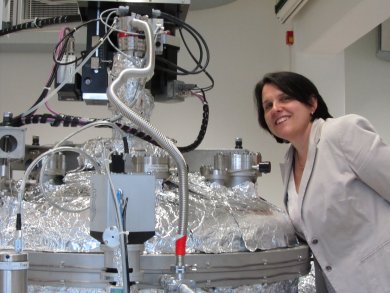Claudia Felser is Professor at the Max Planck Institute for Chemical Physics of Solids in Dresden, Germany. She established the research field of Heusler compounds 15 years ago. Here she outlines the fascinating functionalities of these compounds and explains what needs to be done to develop new materials for energy technology.

Materials for technology applications are becoming increasingly complex. Not only are elemental semiconductors based on silicon and germanium widely used, but binary, ternary, and even quaternary semiconductors such as GaN, GaP1–xAsx, or Cu(GaIn)Se2 are playing an important role in electronics and materials for energy conversion. The introduction of more elements allows for more degrees of freedom, such as band-gap tuning and multifunctionality, and the combination of sometimes contradicting properties. Deeper understanding of these materials and their structures can trigger ideas for various applications for example, to find cheap and stable alternatives for existing semiconductors.
Heusler compounds are a remarkable class of materials that contain several metallic elements in one lattice structure. Their general composition is X2YZ, in which X and Y are transition or rare earth metals and Z is a main group element. Half-Heusler compounds are alloys of the composition XYZ. Heusler compounds have been known for a long time, but only recently have a wide range of their extraordinary functionalities attracted significant attention. These have made the compounds attractive as half-metallic high-temperature ferri- and ferromagnets, multiferroic shape-memory alloys, and topological insulators. These are not only interesting for energy technology, but also for spintronics and magnetocaloric applications. Spintronics is the study of the role that electron spins play in solid-state materials.
Half-Heusler compounds and Heusler compounds are a large class of materials with more than 1000 members, and many unexplored properties. Theoretically, we can design Heusler compounds with the appropriate properties for a wide range of new areas of research.
15 years ago we started with magnetic Co2-Heusler compounds, because of their special electronic structures. These magnetic materials are semiconducting in one spin direction and metallic in the other. This means that electrons responsible for the transport all have the same spin direction, a property required for new devices in spintronics. Potential applications might include disc read heads and nonvolatile storage elements. We are interested in magnetic Heusler compounds for spintronics, rare-earth-free permanent magnets, magnetic cooling devices, and magnetic data-storage devices.
Excellent materials with a high figure of merit can be designed by using tricks to overcome physical limitations: for example, dendritic phase separation in Heusler compounds for thermoelectric applications allows the optimization of two contradicting properties: electrical conductivity and thermal conductivity, connected through the Wiedemann–Franz law. New permanent magnets need a high moment and large coercive fields. Soft magnets have high moments but most materials with high coercive fields have low moments. If we can realize an intrinsic phase separation between a soft Heusler compound with a high moment and another Heusler with a large coercive field, permanent magnets with high energy production should be possible.
Another example are the nonmagnetic Heusler semiconductors ZrNiSn and TiCoSb. Although zirconium, nickel, and tin are metals, the resulting compound is a semiconductor and a good thermoelectric material. The thermoelectric properties of the n-type system RNiSn (R = Zr, Ti, Hf) can be strongly improved by an intrinsic phase separation (ZT > 1). This design concept can also be transferred to p-type TiCoSb, resulting in a record figure of merit of 1.2. There are thousands of unexplored compounds but to date only a few theoretical physicists have started to predict new properties and new compounds.
On looking at the energy supply of the future, in my opinion materials science can help with more efficient information technology through new materials, devices, and concepts; by providing better and sustainable materials for energy conversion; and by combining different conversion technologies to create new energy-conversion technologies, such as thermoelectrics and spintronics to spincaloritronics. My dream is to design these new materials with new functionalities on the computer for a plethora of advanced technologies. Atom-by-atom synthesis by means of thin film and molecular beam epitaxy will enable us to grow metastable materials with multifunctionalities.
Your thoughts:
What role do Heusler compounds play for smart energy?
References
- Design Scheme of New Tetragonal Heusler Compounds for Spin-Transfer Torque Applications and its Experimental Realization, Jürgen Winterlik, Stanislav Chadov, Arunava Gupta, Vajiheh Alijani, Teuta Gasi, Kai Filsinger, Benjamin Balke, Gerhard H. Fecher, Catherine A. Jenkins, Frederick Casper, Jürgen Kübler, Guo-Dong Liu, Li Gao, Stuart S. P. Parkin, Claudia Felser, Adv. Mat. 2012, 24, 6283–6287. https://doi.org/10.1002/adma.201201879
- Simple Rules for the Understanding of Heusler Compounds, Tanja Graf, Claudia Felser, Stuart S. P. Parkin, Progr. Solid State Chem. 2011, 39, 1–50. https://doi.org/10.1016/j.progsolidstchem.2011.02.001
- Spintronics: A Challenge for Materials Science and Solid-State Chemistry, Claudia Felser, Gerhard H. Fecher, Benjamin Balke, Angew. Chem. Int. Ed. 2007, 46, 668–699. https://doi.org/10.1002/anie.200601815
- M. Koehne, T. Graf, H. J. Elmers, C. Felser, US Patent 20,130,156,636, 2013.
- Enhanced thermoelectric performance in the p-type half-Heusler (Ti/Zr/Hf)CoSb0.8Sn0.2 system via phase separation, Elisabeth Rausch, Benjamin Balke, Siham Ouardi, Claudia Felser, Phys. Chem. Chem. Phys. 2014, 16, 25258–62. https://doi.org/10.1039/c4cp02561j and preprint arXiv:1502.03336.



